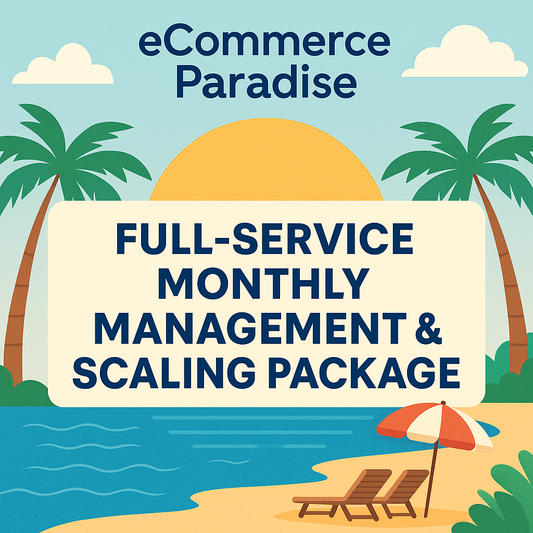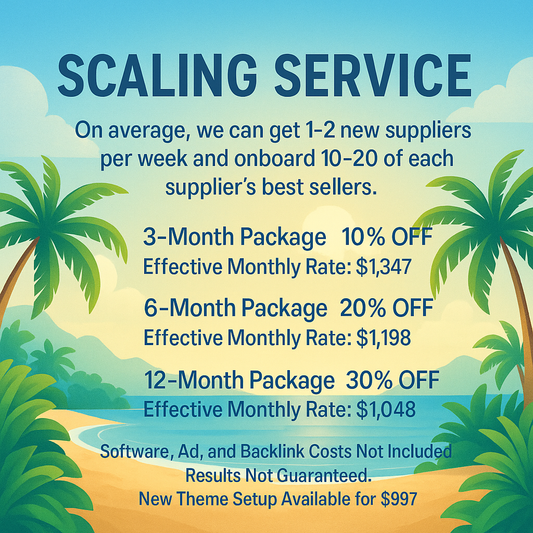How to Track and Optimize Your Shopify SEO Strategy Over Time
Why SEO is never “done” — and how to monitor and scale your results
If you’ve already put in the work to optimize your Shopify store for SEO — from keywords and structure to content and backlinks — congrats. You’re ahead of 90% of store owners.
But here’s what most people miss:
SEO is not a set-it-and-forget-it game.
To grow consistently and stay ahead of competitors, you need to regularly track what’s working, what’s not, and make small ongoing improvements.
In this guide, I’ll show you how to monitor your SEO performance and scale what’s working to drive even more traffic and sales over time.
Why Tracking SEO Is Essential
Google’s algorithm is always changing. Your competitors are improving. And even your best-performing content will eventually become outdated if you ignore it.
Tracking and optimizing your SEO helps you:
-
Spot which pages are rising (or falling) in search
-
Understand which keywords are driving real traffic
-
Improve your click-through rates and engagement
-
Make better content and product page decisions
-
Continuously compound your results over time
Tools to Track Your SEO Performance
Here are the key tools you should have set up and check regularly:
Google Analytics
Track total organic traffic, behavior flows, time on page, bounce rates, and conversions from search traffic.
Google Search Console
See what queries you’re ranking for, your average position, click-through rate (CTR), and which pages are getting the most impressions or clicks.
Bing Webmaster Tools
Similar to Google Search Console — and helpful if you want visibility on Microsoft search traffic.
Keyword Tracking Tools (Optional but Helpful):
-
Ahrefs
-
Ubersuggest
-
SEMrush
-
Rank Tracker
-
SurferSEO
These tools let you monitor keyword rankings and flag sudden drops or gains.
What to Monitor Regularly
Here’s what you should keep an eye on, weekly or monthly:
1. Total Organic Traffic
Look at traffic trends from organic search over the past 30 days, 90 days, and year-over-year. Is it growing, steady, or declining?
2. Top Pages by Traffic and Clicks
Which product, collection, and blog pages are performing the best? Can you build on those or promote them more?
3. Keyword Rankings
Track 10–30 of your most important keywords and watch their movement in search engine results.
4. Click-Through Rate (CTR)
If a page ranks but no one clicks it, the title or meta description might need improvement.
5. New Keywords and Queries
Look for unexpected keyword impressions or new queries your site is showing up for — they might spark new content ideas.
6. Pages Losing Traffic or Impressions
Pages that were ranking well but are starting to slip should be updated or re-optimized ASAP.
How to Optimize Existing Pages
Here are simple ways to improve and update your content and pages over time:
Update Old Blog Posts
Add new sections, updated stats, product mentions, or internal links. This keeps your content fresh in Google’s eyes.
Expand Thin Product or Collection Pages
If a key page only has a few sentences, consider adding FAQs, use cases, reviews, or video content.
Improve On-Page SEO
Re-check your title tags, meta descriptions, H1s, alt text, and keyword usage. Small tweaks can improve CTR and rankings.
Add Internal Links
Link older pages to newer ones (and vice versa). This helps Google crawl and connect content better — and boosts underperforming pages.
Create New Supporting Content
If a product or collection is doing well, write a blog post that supports it and links back to it.
Pro Tip
Create a simple tracking sheet (Google Sheet or Notion board) with the following columns:
-
URL
-
Target keyword
-
Current rank
-
Impressions
-
Clicks
-
CTR
-
Last updated date
-
Notes (like what changes you made)
Review this once a month and update 3–5 pages at a time. That’s all it takes to stay ahead.
SEO Tracking & Optimization Checklist
-
Google Analytics and Search Console installed and verified
-
Keyword tracking set up for 10–30 core keywords
-
Top traffic pages identified and monitored
-
CTR reviewed for top-performing and underperforming pages
-
Old blog posts reviewed and refreshed
-
Thin content expanded
-
Internal linking updated regularly
-
New keyword opportunities flagged for future content
Want Help?
If you’d like support analyzing your traffic, planning updates, or building out a content-driven SEO system — we’ve got you.
Download the Ultimate SEO Checklist
Book a Free SEO Audit
Join the Ecommerce SEO Course + Discord Community


















